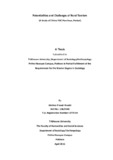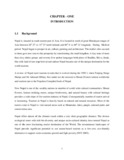Please use this identifier to cite or link to this item:
https://elibrary.tucl.edu.np/handle/123456789/586Full metadata record
| DC Field | Value | Language |
|---|---|---|
| dc.contributor.author | Paudel, Krishna Prasad | - |
| dc.date.accessioned | 2021-07-06T07:22:55Z | - |
| dc.date.available | 2021-07-06T07:22:55Z | - |
| dc.date.issued | 2011 | - |
| dc.identifier.uri | http://elibrary.tucl.edu.np/handle/123456789/586 | - |
| dc.description.abstract | In the scenario of low productivity in agricultural and industrial sector, tourism can be a high productive sector to compensate the unemployment and disguised unemployment prevailing in the country as well as Panchase Region (PA). It has comparative advantages than other industries such as, it has low opportunity cost, it takes low gestation period to give returns, can involve the lower strata of the people of all ecological zones, involves women and ethnic groups and bears direct relation to all dimensions of life like culture, environment, nature, behavior of people etc. Pokhara and around is highly potential for tourism as it is a storage area of nature and living culture. The region has been a role model for rural tourism development (RTD) in the country such as Sirubari, Ghalegaun. Panchase Region under which is also rich in cultural heritage, beautiful natural scenery, colorful fairs and festivals, views of breathtaking Himalayas, pristine natural beauty, hospitable people and ancient religious and historical monuments make this is one of the most wonderful tourist destinations, is crying for its proper attention. Tourism has been increasingly used for, and directly linked with, rural poverty reduction in developing countries like Nepal. However, the application, and to an extent the principles, of the widely used organising framework for considering poverty reduction, the Rural Tourism development (RTD), may not fit fully the tourism situation, and vice versa. Based on a review of the Finding of respondents and literature from the study of potentialities and challenges in Panchase region, particularly Chitre VDC we first suggest that sustainable for tourism should be viewed in a broader tourism context, rather than merely taking tourism as a development tool. Second, the RT in PA region local seeks the individual or household level, while tourism sustainability is often applied to the industry and destinations at wider, more macro level scales. Thus, a reconciliation of the tensions and opportunities between the RTD and tourism needs to be found conservation valuable biodiversity, Unique herbs, protection wild animal from hunting, land degradation by name of motor able road of forest area in Panchase region Third, concept of Local Individual and institutional asset (mainly community participation) needs to be incorporated within the SRTD in PA. Given the above understandings, the potential applications of the sustainable rural tourism Development are discussed and future research is recommended. | en_US |
| dc.language.iso | en_US | en_US |
| dc.publisher | Department of Sociology/ Anthropology Prithvi Narayan Campus Pokhara | en_US |
| dc.subject | economic situation | en_US |
| dc.subject | rural tourism. | en_US |
| dc.title | Potentialities and Challenges of Rural Tourism (A Study of Chitre VDC Panchase, Parbat) | en_US |
| dc.type | Thesis | en_US |
| local.institute.title | Prithivi Narayan Campus, Pokhara | en_US |
| local.academic.level | Masters | en_US |
| Appears in Collections: | Sociology | |
Files in This Item:
| File | Description | Size | Format | |
|---|---|---|---|---|
| Cover Page(6).pdf | 68.14 kB | Adobe PDF |  View/Open | |
| Chapter Page(1).pdf | 699.95 kB | Adobe PDF |  View/Open |
Items in DSpace are protected by copyright, with all rights reserved, unless otherwise indicated.
